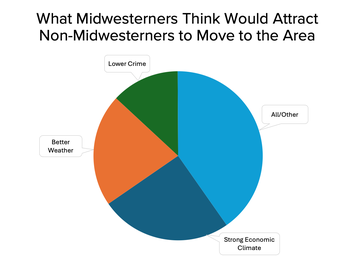
Yesterday, I conducted a poll on X to ask people what would have to change in large Midwestern metros for non-Midwesterners to consider moving here. The poll was revealing.
I introduced three options to vote for – a strong economic climate; better weather, and lower crime – and a fourth catch-all option for other positions. I went into this thinking the “better economy” option would win, and it did. Complaints about the Midwest’s cold and snow frequently show up as reasons to avoid the Midwest, and that view finished in a strong second. Based on the negative press coverage that cities like Chicago receive on violent crime, I thought “much lower crime” would rank highly, but it did not.
The “all/other” option, however, had a surprise, to me. It largely had two types of responses. One was a significant number of people who said better public transit, less auto dependency and more walkable neighborhoods would make them consider Midwestern living. Nice, but that comes across to me as virtue signaling; that can be said for every metro except the five in America that have actual transit systems and/or walkable neighborhoods. But the other was the Midwest’s lack of openness – its unwillingness to welcome newcomers, or adapt its culture to bring in outsiders.
It’s a bigger problem than many Midwesterners would admit. Yet it’s also a perception problem that outsiders need to get over.
Without a doubt, the region has earned this reputation. It usually comes up quickly in first conversations with people – “where’d you grow up? What high school did you go to?” Many Midwesterners try to make an immediate regional connection with someone, in a way that’s off-putting to someone who isn’t originally from here.
As the region that’s exported more people to other parts of the nation than any other, Midwestern provincialism has likely deepened over the last half century or so. Why? I think it’s become a marker for residents, a source of pride – a reminder that the more things change, the more they stay the same.
But it’s not as if other regions in America are actually less insular. They’ve actually seen more influx of outsiders and had greater diversity and heterogeneity thrust on them.
Let’s start with the East Coast, specifically the Northeast. One could argue that Boston and New York City specifically, and New England and the mid-Atlantic more broadly, both developed very early on with visions of superiority related to education (Boston and Ivy League locales) and business (New York, Washington, DC, to a lesser extent Philadelphia). The East Coast became America’s proving grounds for any American who was ambitious. They built on that legacy and it continues to feed their growth – and feelings of superiority – today.
Read the rest of this piece at The Corner Side Yard.
Pete Saunders is a writer and researcher whose work focuses on urbanism and public policy. Pete has been the editor/publisher of the Corner Side Yard, an urbanist blog, since 2012. Pete is also an urban affairs contributor to Forbes Magazine's online platform. Pete's writings have been published widely in traditional and internet media outlets, including the feature article in the December 2018 issue of Planning Magazine. Pete has more than twenty years' experience in planning, economic development, and community development, with stops in the public, private and non-profit sectors. He lives in Chicago.












